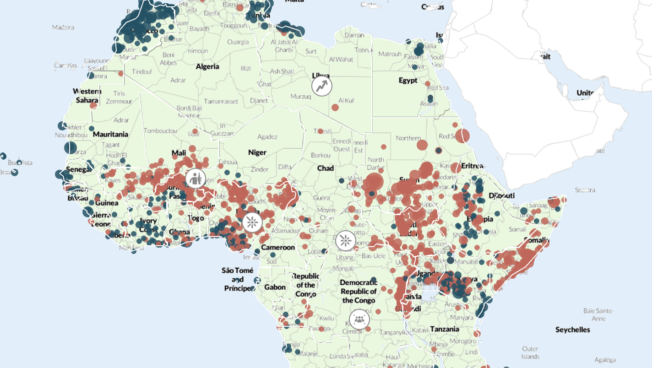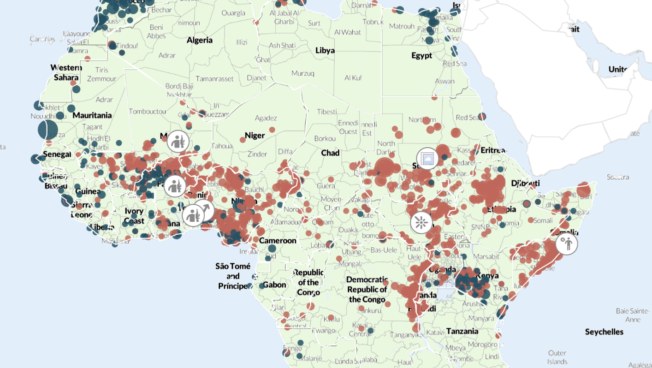Regional Overview
Africa
August 2024
Posted: 6 September 2024
In this Regional Overview
- Burkina Faso: JNIM’s deadly campaign intensifies
- Democratic Republic of the Congo: Wazalendo contestation escalates against the M23
- Mali: JNIM launches a widespread offensive after Wagner’s defeat in Kidal
- Nigeria: Anti-government demonstrations break out nationwide
- South Sudan: Sudan conflict spills over into Upper Nile state
- Sudan: Spikes in the use of explosives and remote violence by the SAF and RSF
Burkina Faso: JNIM’s deadly campaign intensifies
Violence involving al-Qaeda-affiliated Jama’at Nusrat al-Islam wal-Muslimin (JNIM) was particularly deadly last month in Burkina Faso. ACLED records over 950 reported fatalities, which constitutes a 117% increase in fatalities compared to July. JNIM carried out two large-scale offensives near Nassougou, Gourma province, and in the town of Barsalogho, Sanmatenga province, that contributed to over half of the reported fatalities resulting from incidents involving JNIM in August. These assaults led to fighting with soldiers and Volunteers for the Defense of the Homeland (VDP) fighters, as well as attacks on civilians. Later, JNIM denied targeting civilians in a statement issued by the group’s al-Zallaqa media wing.1David Lewis, ‘Al Qaeda branch says it killed 300 fighters, not civilians, in Burkina Faso attack,’ Reuters, 29 August 2024 Overall, more than 95% of the fatalities that occurred in Burkina Faso last month involved JNIM.
Democratic Republic of the Congo: Wazalendo contestation escalates against the M23
Since the signing of humanitarian and ceasefire agreements between Congolese and Rwandan officials on 5 July and 4 August, respectively,2Okeri Ngutjinazo, ‘Congo-Rwanda cease-fire: A lasting peace effort?’ Deutsche Welle, 1 August 2024 levels of political violence have remained lower in North Kivu. Despite this overall reduction in violence, battles involving the March 23 Movement (M23) rose by more than 55% in August compared to July while remaining under the monthly average over the past year. Last month, the main opponent of the M23 transitioned from the Congolese military (FARDC) to the Wazalendo, a coalition of armed groups aligned with the military and also referred to as the Awakening of Patriots for the Liberation of Congo (EPLC). Wazalendo militants were involved in at least 85% of battles against the M23 in August, with ACLED recording at least 30 battles involving the two sides, up from 13 events in July. The increasing involvement by Wazalendo marks a concerning shift, as rising contestation with Wazalendo militants previously eroded peace agreements after the M23 accused the Congolese government of proxy warfare through the Wazalendo,3Mary Wambui, ‘EAC raises concerns over new hostilities in Eastern DR Congo,’ The East African, 13 October 2023 which led to renewed fighting in October 2023 after six months of reduced hostilities.
Mali: JNIM launches a widespread offensive after Wagner’s defeat in Kidal
In August, JNIM launched a widespread offensive in the central, western, and northern regions of Mali. In late July, JNIM and the Strategic Framework for the Defense of the People of Azawad (CSP-DPA) conducted simultaneous offensives against the Wagner Group and Malian military (FAMa) in the Tin Zaouatene area, Kidal region, where Wagner suffered its deadliest defeat in Africa. After violence involving JNIM declined in June and July, the offensive led to a 5% rise in violence in August compared to July. Amidst the August offensive, JNIM overran numerous FAMa positions, including the towns of Yelimane, Melga, and Nioro du Sahel in the Kayes region; Kouakourou in the Mopti region; Diallassagou in the Bandiagara region; and Gossi in the Tombouctou region. In retaliation, FAMa carried out over a dozen aerial strikes last month. While several air and drone strikes hit JNIM and CSP-DPA positions, civilians were hit on several occasions, leading to at least 49 reported fatalities. FAMa and Wagner also launched Operation Vengeance4X, @Wamaps_news, 30 August 2024 with military buildups at the Gao airport.5X, @casusbellii, 29 August 2024
Nigeria: Anti-government demonstrations break out nationwide
Following youth-led movements against the governments in Uganda and Kenya in recent months, widespread anti-government demonstrations kicked off across Nigeria on 1 August, prompting deadly responses from state forces and armed groups. Using hashtags on social media such as #RevolutionNow, #TinubuMUSTGo, and #EndBadGovernanceInNigeria, grassroots youth activists organized numerous demonstrations against issues like poor governance, rising costs of living, hunger, and fuel prices.6Ochogwu Sunday, ‘Anti-government protest: TinubuMustGo hashtag trends on social media,’ 19 July 2024 Demonstrations in Nigeria rose by 55% last month, with nearly 70 events on 1 August alone. A third of the demonstrations devolved into violence, resulting in security forces dispersing gatherings by making arrests, using tear gas, and firing live ammunition. In addition to police dispersion, unidentified armed groups and counter-demonstrators also interacted with the gatherings to dispel the crowds or carry out violence against demonstrators. Collectively, actions by security forces and armed groups led to 20 reported fatalities during demonstrations last month, making August the deadliest month of demonstrations since the #EndSARS movement in October 2020.
South Sudan: Sudan conflict spills over into Upper Nile state
In Upper Nile state, violence spilled over from Sudan amidst ongoing contestation between military forces and local militias. A rare airstrike hit civilians in the Khor Tombak area of Maban county after Sudanese Armed Forces (SAF) fighter jets reportedly targeted the Rapid Support Forces (RSF) and the faction of Sudan People’s Liberation Movement-North (SPLM-N) led by Joseph Tuka. RSF paramilitaries had moved to Renk county in Upper Nile state in April 2023 after being dislodged from areas of Sudan.7Crisis Group, ‘Crisis Watch: South Sudan,’ April 2023 These were the first airstrikes to hit Upper Nile since July 2017, when Ugandan military forces bombed armed groups near Pagak. The SAF airstrike came in addition to ongoing battles between military forces and local militias in the area, as well as several attacks on civilians. Violence involving Sudanese state forces last moved into Upper Nile state in February 2023, prior to the current outbreak of hostilities between the RSF and SAF, when gunmen affiliated with the SAF crossed into Renk county and attacked civilians who were collecting zakat. ACLED’s Trendfinder shows the increasing volatility of Upper Nile State in 2024, with frequent deviations from baseline violence levels.
Sudan: Spikes in the use of explosives and remote violence by the SAF and RSF
As the conflict between the SAF and RSF continued for its 17th month, both sides increased their use of remote violence, deploying airstrikes, drones, and artillery fire. While the SAF has long used its aerial advantages against the RSF, August marked a critical point in the evolution of aerial conflict in the country with an escalation in the RSF’s use of attack drones. The United Arab Emirates and Russia-backed Wagner Group have long supplied drones — some made locally — to the RSF.8Abdelrahman Abu Taleb, ‘Evidence of Iran and UAE drones used in Sudan war,’ BBC, 13 June 2024 However, the RSF also captured a large number of SAF military locations in June and July, which may have increased the RSF’s drone stockpile. The RSF’s use of explosives and remote violence in August was at its highest level since the conflict broke out, more than doubling the monthly average since April 2023. Remote violence continued to be concentrated in Khartoum state but also escalated in River Nile and East Darfur — states that had yet to see an escalation of aerial attacks. The increased use of aerial warfare may also signal a tactical shift, with each side expanding offensives into new areas.
See More
See the Codebook and the User Guide for an overview of ACLED’s core methodology. For additional documentation, check the Knowledge Base. Region-specific methodology briefs can be accessed below.
Links:
For additional resources and in-depth updates on the latest political violence and protest trends, check our local observatories for Mozambique and Ethiopia, as well as our special Nigeria Election Violence Tracker project.







